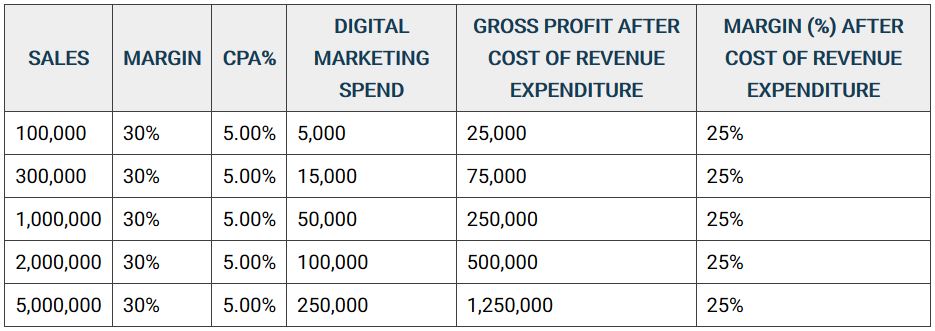Key points:
• Cost Per Acquisition percentage (CPA%) is the core metric for digital marketing investment and should be monitored each month.
• A Target CPA% must be agreed – the actual monetary investment will grow with sales.
• Digital marketing is an investment that directly drives returns in the form of sales – stop this and sales will crash.
• Businesses need to regularly review and reforecast online marketing budgets to maintain the growth.
Introduction
On Amazon or eBay, Finance Directors understand that you have to pay the selling costs to sell the item on the marketplace, otherwise you will have no sales from that marketplace. For most products on Amazon, this selling cost is around 20%.
However, when selling on their own company website, online marketing costs (such as Google PPC, Facebook Ads or Affiliate Marketing) can be seen purely as an optional overhead as opposed to an investment to generate revenue. This can lead to stop-start online marketing spend which leads to failed marketing campaigns, wasted investment and lower revenues.
So how can this expenditure be properly invested and assessed?
As budgets are reduced and businesses look more closely at their expenditure, a good return on investments becomes more critical.
This is no different for ecommerce marketing spend. After all, the digital marketing budget is an investment from which returns are expected.
It is important that, when it comes to digital marketing, companies measure the results and assess the success (or otherwise) of the spend in driving sales.
What should be your budget for digital marketing? This depends on your market – its maturity, its size and what the potential impact of the spend is on sales.
It will also depend heavily on your sales target and the aggressiveness of your growth plan.
Benchmarking and allocating a target CPA% to digital marketing
Benchmarking is useful but, irrespective of what other businesses are spending, you will be constrained by what your business considers affordable.
There are a variety of digital marketing channels and it is important that you are investing in the channel that is right for your business to drive maximum sales return.
What is an acceptable return? There is no single figure that indicates a good return on your marketing investment.
Obviously, measuring sales growth is important and you need to have set a sales target – but at what cost were those sales achieved?
At IRP Commerce we use the measure Cost Per Acquisition percentage (CPA%) as the core metric to follow in online marketing costs. This is derived from the cost of a channel divided by the sales from a channel and is effectively an indicator of the cost to achieve the sales.
CPA% is an important KPI for digital marketing spend. The objective is to keep this number as low as possible whilst driving the maximum sales. It is therefore a sensitive balance and should be controlled through the setting of an agreed Target CPA%.
When setting a budget for digital marketing it is important to remember that, with success and increased sales, the monetary value of the digital marketing investment should also increase so that sales do not plateau.
That is why a Target CPA% is the key metric for businesses to understand and not a monetary value. Once a Target CPA% has been agreed, the actual monetary investment will grow with sales.
Ongoing review and reforecasting of your digital marketing budget
It is fundamental for digital transformation in ecommerce that CPA% is fully understood by the business.
This means that, as with all targets and budgets, the business needs to regularly review and reforecast for new information to make sure that the balance remains between the investment in digital marketing and maximum revenue growth – otherwise growth will stall.
Table 1. Example

In this example, the CPA% target (being the minimum investment for the maximum return) has been set at 5% and sales have grown as has the investment in digital marketing.
Although the margin % has dropped from 30% to 25% after the cost of revenue expenditure, in monetary terms the investment has increased sales and gross profit after the cost of revenue expenditure from £25,000 to £1,250,000.
In this case, if you were to set your CPA% target lower, investment would be less – but so would the sales and the gross profit after the cost of revenue expenditure.
Conclusion
When setting the CPA% target you need to have a clear understanding of your sales target and your product margins.
You can then assess the impact on those margins of revenue-driver costs such as IRP platform transaction fees and digital marketing.
Although the marketing objective is to drive sales, it is important to know that they are profitable sales.
By viewing digital marketing as an investment that directly drives returns in the form of sales and as a cost of revenue, your business will be pushed to focus on value, maximising sales returns for the least cost.
Your ecommerce and digital marketing departments will be forced into accountability and transparency. They will be able to demonstrate success and have a real impact on your business.